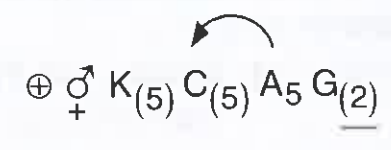The floral formula of family Brassicaceae includes all, except
K2+2
A2+4
G1
C4
The correct Answer is:3
To solve the question regarding the floral formula of the Brassicaceae family, we will follow these steps:
1. Understanding the Brassicaceae Family:
- The Brassicaceae family, also known as the mustard family, has a specific floral formula that we need to analyze.
2. Identifying Floral Characteristics:
- The floral formula of Brassicaceae is typically represented as K4 C4 A2+4 G(2).
- Here, K represents the calyx, C represents the corolla, A represents the androecium (stamens), and G represents the gynoecium (carpels).
3. Analyzing Each Component:
- Calyx (K): The calyx is usually composed of 4 sepals (K4).
- Corolla (C): The corolla consists of 4 petals (C4).
- Androecium (A): The androecium has 2+4 stamens (A2+4), which indicates that there are 2 short and 4 long stamens.
- Gynoecium (G): The gynoecium is bicarpillary and syncarpous, meaning it has 2 fused carpels (G(2)).
4. Identifying the Exception:
- The question asks which component is not included in the floral formula of the Brassicaceae family.
- From the breakdown, we can see that the components are K4, C4, A2+4, and G(2).
5. Conclusion:
- The exception in the floral formula of the Brassicaceae family is related to the gynoecium. The typical structure is syncarpous with a superior ovary, but if an option suggests a different structure (like a different number of carpels or an inferior ovary), that would be the correct answer.
- Therefore, the correct answer to the question is the option that does not fit the characteristics outlined above.
Final Answer:
The floral formula of the Brassicaceae family includes all, except the option that describes a different gynoecium structure.
---
- The Brassicaceae family, also known as the mustard family, has a specific floral formula that we need to analyze.
- The floral formula of Brassicaceae is typically represented as K4 C4 A2+4 G(2).
- Here, K represents the calyx, C represents the corolla, A represents the androecium (stamens), and G represents the gynoecium (carpels).
- Calyx (K): The calyx is usually composed of 4 sepals (K4).
- Corolla (C): The corolla consists of 4 petals (C4).
- Androecium (A): The androecium has 2+4 stamens (A2+4), which indicates that there are 2 short and 4 long stamens.
- Gynoecium (G): The gynoecium is bicarpillary and syncarpous, meaning it has 2 fused carpels (G(2)).
- The question asks which component is not included in the floral formula of the Brassicaceae family.
- From the breakdown, we can see that the components are K4, C4, A2+4, and G(2).
- The exception in the floral formula of the Brassicaceae family is related to the gynoecium. The typical structure is syncarpous with a superior ovary, but if an option suggests a different structure (like a different number of carpels or an inferior ovary), that would be the correct answer.
- Therefore, the correct answer to the question is the option that does not fit the characteristics outlined above.
The floral formula of the Brassicaceae family includes all, except the option that describes a different gynoecium structure.
Topper's Solved these Questions
- MORPHOLOGY OF FLOWERINGPLANTS Book:VMC MODULES ENGLISHChapter:MORPHOLOGY OF FLOWERINGPLANTS Exercise:IN-CHAPTER EXERCISE-F
Explore 9 Videos
- MINERAL NUTRITIONBook:VMC MODULES ENGLISHChapter:MINERAL NUTRITIONExercise:IMPECCABLE
Explore 55 Videos
- ORGANISMS & POPULATIONS Book:VMC MODULES ENGLISHChapter:ORGANISMS & POPULATIONS Exercise:In - Chapter exercise C
Explore 10 Videos
Similar Questions
 is floral formula of
is floral formula of
View SolutionFloral formula of family fabaceae is
View Solution is the floral formula of
is the floral formula of
View Solution is the floral formula of
is the floral formula of
View Solution is the floral formula of :
is the floral formula of :
View Solution is floral formula is
is floral formula is
View SolutionFloral formula of Pea is
View SolutionThe floral formula for Brassicaceae family is
View Solution is the floral formula of :-
is the floral formula of :-
View SolutionThe floral formula
 is that of
is that of
View Solution